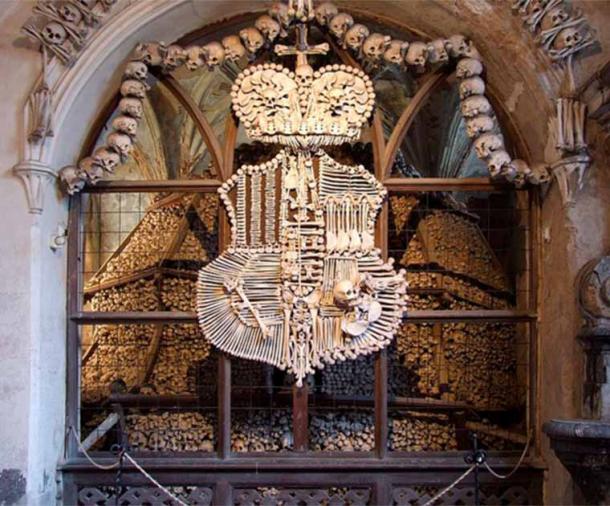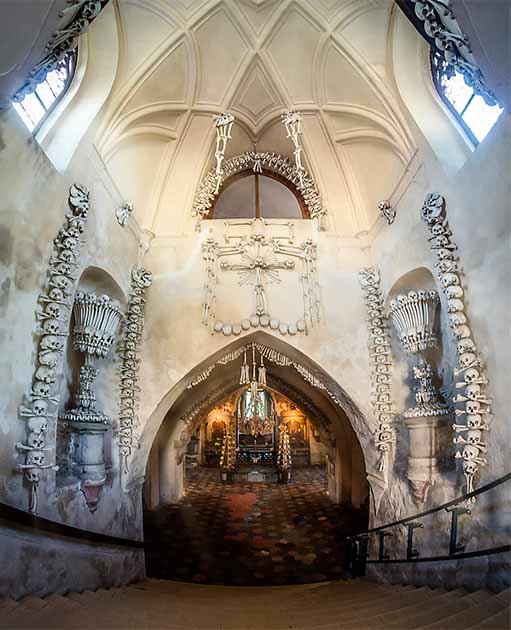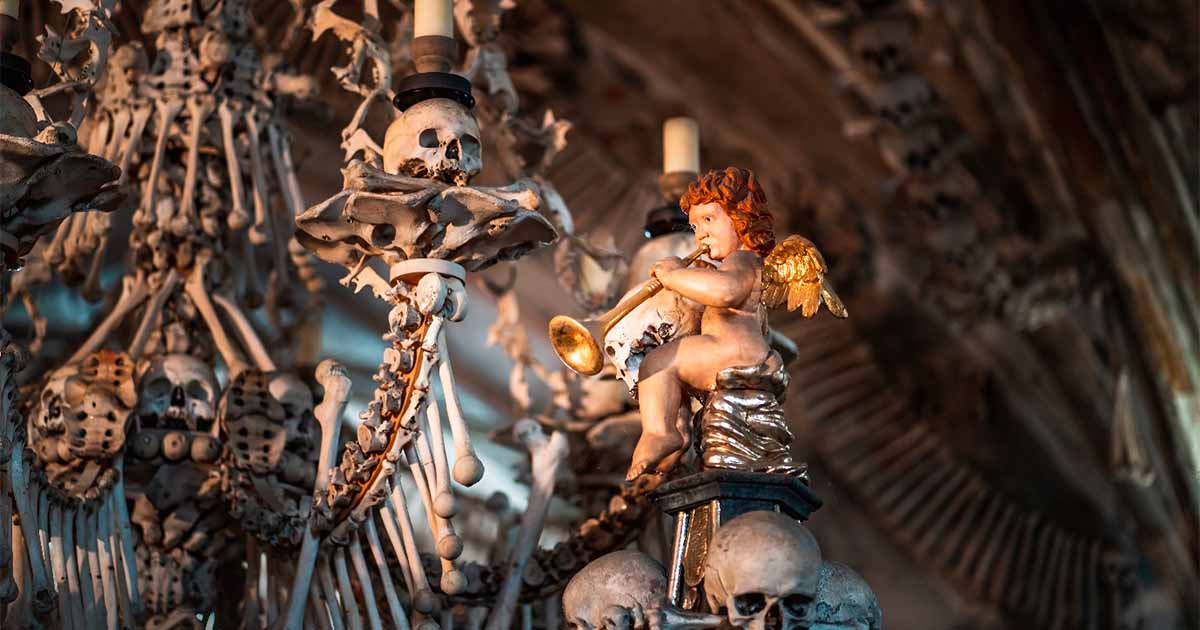The Eerie Charm of Sedlec Ossuary: A Gothic Masterpiece of Human Bones
Deep beneath the Cemetery Church of All Saints in Sedlec, Czech Republic, a chilling monument to human mortality has been carefully crafted over the centuries. Decorated with the bones of over 40,000 souls, the small Roman Catholic chapel is adorned with bone chandeliers, candelabras crafted from femurs, and even family crests and monstrances. The eerie Sedlec Ossuary is now one of the most popular tourist destinations in the region, drawing in visitors who are both fascinated and unsettled by the somber displays. But while some may find the bone church macabre or even grotesque, others see it as a poignant reflection of the belief that the body is merely a temporary vessel for the soul.

A coat of arms made of bones in Sedlec Ossuary bone church. (Pudelek / CC)
Origins of the Bone Church
The chapel has a long history, beginning in 1142 when a Cistercian monastery was founded in Sedlec. One of the tasks of the monks was the cultivation of the grounds around the monastery. In 1278, King Otakar II of Bohemia sent the Abbot of Sedlec Monastery (Abbot Henry) on a diplomatic mission to the Holy Land. When he returned from Jerusalem, he brought back a handful of earth from Golgotha and he scattered the ‘holy soil’ over the cemetery of Sedlec monastery. From then on, it became the most desired place to be buried in the region.
People all over Bohemia and Central Europe, particularly wealthy people, requested that they be buried in the holy cemetery, and many were. A solution was needed to cope with the influx and so in 1511, an ossuary was built to store the skeletal remains. An ossuary is frequently used when burial space is scarce. A body is first buried in a temporary grave and then after some years, the skeletal remains are placed in the crypt or ossuary. This task was given to a half-blind monk who spent his time gathering bones and stacking them to make room for the new bodies coming into the cemetery.
Bursting With Bones After the Black Plague
The capacity of the cemetery was to become stretched even further when the Black Plague broke out in the 14 th century and thousands of citizens who succumbed to the disease needed to be promptly buried. Added to this was the Hussite wars in the first quarter of the 15 th century, which led to thousands more deaths. It wasn’t long before the cemetery was literally bursting at the seams. In Sedlec, the bones of tens of thousands of people were moved into the safe storage of the crypt, which became known as Sedlec Ossuary.

The chandelier made of bones in Sedlec Ossuary (Pudelek / CC)
A 19th Century Masterpiece Emerges
In 1870, a local woodcarver, František Rint was employed for the dark task of putting the bone heaps into order. And that he did! Rint spent years assembling the bones, but not into near piles against the walls. Rather, Rint used his artistic talents to create a masterpiece, which is now known as ‘The Church of Bones’. The bones were used as a decoration and superimposed over the pre-existing structure of the Church made of bricks and stone. He bleached the bones in order to give the room a uniform look and set about forming his creations, including candelabras, altars and coat of arms. But the most impressive piece of art is the central chandelier, which was built with at least one piece of every bone present in the human body.

Sedlec Ossuary, Kutna Hora. (Nick M / Flickr)
Ossuaries of Europe
Ossuaries are not unique to Sedlec in the Czech Republic. There are many examples of ossuaries across Europe, including the Santa Maria della Concezione dei Cappuccini in Rome, Italy, the San Bernardino alle Ossa in Milan, Italy, and the Skull Chapel in Czermna, Poland. Another well-known ossuary is the Capela dos Ossos (Chapel of bones) located in Évora, Portugal. The more recent Douaumont ossuary in France contains the remains of more than 130,000 French and German soldiers that fell at the Battle of Verdun during World War I.
These ossuaries were created to house the remains of thousands of individuals in response to the lack of space for traditional burials. They have become popular tourist attractions due to their unique and eerie aesthetic, as well as their historical significance.
The bone church of Sedlec is a unique and eerie reminder of human mortality and the historical impact of the Black Plague and wars on European society. The artistic and symbolic use of human bones in the chapel can be seen as both a form of remembrance and a reflection of the belief that the physical body is just a temporary vessel for the soul. While some may view the church as morbid or disrespectful, it remains an important cultural and historical landmark in the Czech Republic
Top image: Details at Sedlec Ossuary Interior, Kutna Hora, Czech Republic. Source: diegograndi / Adobe Stock
References
Atlas Obscura. Sedlec Ossuary “Bone Church”. Available from: https://www.atlasobscura.com/places/sedlec-ossuary
Nomad Travellers. Bone Church in Kutna Hora, visit the Sedlec Ossuary. Available from: https://www.nomadtravellers.com/visit/kutna-hora-bone-church-sedlec-ossuary
Twisted Sifter. Sedlec Ossuary: The Bone Church of 40,000 Souls. Available from: https://twistedsifter.com/2012/08/sedlec-ossuary-bone-church-czech-republic/




















Comments
"the cemetery was literally bursting at the seams"
I hope they've managed to repair the seams since then!